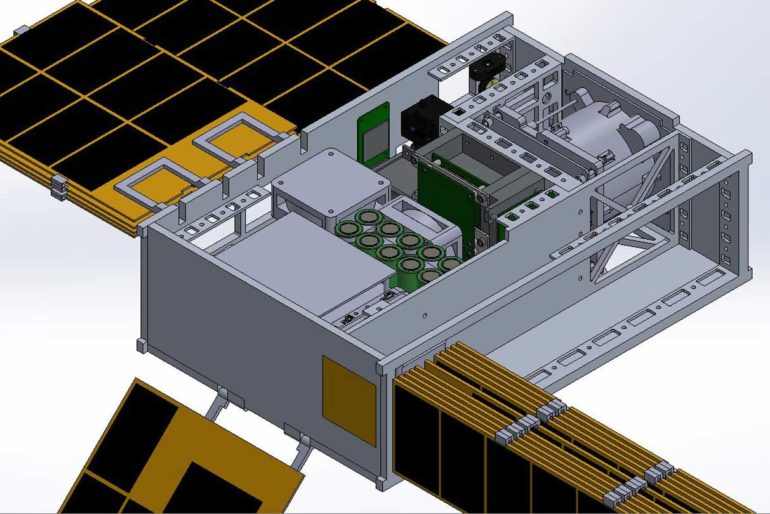Science aboard an Alabama Space Grant Consortium (ASGC) student-led cube satellite mission called AEGIS could be valuable to developing future human outposts on the moon and in space travel to Mars if NASA gives the go-ahead for a 2022 flight.
Based at The University of Alabama in Huntsville (UAH), ASGC member universities are Alabama A&M University, Auburn University, Tuskegee University, The University of Alabama, The University of Alabama at Birmingham, UAH and the University of South Alabama, and all are involved in AEGIS.
An experiment to test the radiation-shielding properties of simulated lunar soil, or regolith, is aboard the AEGIS CubeSat under development. The science is important to future lunar colonies because transporting shielding materials to the moon will be expensive, says Dr. Michael Briggs, assistant director of UAH’s Center for Space Plasma and Aeronomic Research (CSPAR) and a principle research scientist who is advising the AEGIS science mission.
“In contrast, lunar regolith will be readily available,” he says. “Calculations show that lunar regolith will work well as a shield and NASA is studying its use as a construction material. Our goal is to improve our knowledge of its radiation shielding capacity.”
Future Mars missions could benefit from spacecraft that use lunar regolith as shielding.
“Since the lunar gravity is weaker than the Earth’s,” Dr. Briggs says, “it could be easier to use lunar material for radiation shielding for a spaceflight to Mars.”
ASGC’s 6U CubeSat measures slightly smaller than 4x8x12 inches. The craft will achieve an egg-shaped cislunar orbit that will swing it out from the Earth toward the moon and then back to Earth again.
“It is crucial to test the shielding in a radiation environment equivalent to what astronauts will be exposed to on the surface of the moon or while traveling to Mars,” Dr. Briggs says.
“We can do very useful laboratory testing on the Earth, but there are limitations in generating the flux of high energy cosmic rays,” he says. “Additionally, the interaction probabilities of collisions of heavy nuclei are imperfectly known. Measurements in the relevant environment are the surest validation of shielding.”
ASGC proposed the AEGIS mission in response to NASA’s CubeSat Launch Initiative (CSLI) last fall. The proposal is for AEGIS to launch as a secondary payload aboard the Space Launch System (SLS) on the Artemis II mission. Artemis is NASA’s effort to land the first woman and next man on the moon by 2024 and prepare for human flight to Mars.
“This is a scientific spacecraft that’s designed and will be built by students,” says Dr. Dale Thomas, ASGC director, UAH professor and the eminent scholar in systems engineering. “The student team is incredible. The faculty mentors are doing a great job. The NASA and industry subject matter experts who reviewed their work were really engaged and helpful. I really hope that we get to build this thing.”
Because the CubeSat would orbit far from the Earth, the project is more challenging than most student projects. Over 120 students from ASGC member institutions have been involved so far, potentially making it the largest student spacecraft project in the world, Dr. Thomas says.
“Other programs may have produced more satellites over time,” he says, “but this may be the largest number of students on a single spacecraft.”
Currently, AEGIS’ flight software team is doing tests on a physical onboard computer stand in, the electrical power group is working on a test circuit for solar panel input diodes, and the command and data handling team has built a test printed circuit board. The science team has ordered a silicon detector to start testing.
“In general, what we are doing at component level is working to get familiarity with key hardware elements. Most of the work ahead is still in analysis, so hardware work is supporting that,” Dr. Thomas says.
The overall team has established critical milestones for the project based on the assumed launch date of SLS in October 2022, according to the NASA solicitation. The next major milestone will be the Preliminary Design Review around Thanksgiving.
“The objective of that review is to have completed all of the system trade studies and key technology demonstrations such that we can proceed with the detailed design of the spacecraft,” Dr. Thomas says.
Jared Fuchs, a graduate student in physics from Helena, Ala., is leading the UAH team developing the spacecraft’s regolith experiment. Fuchs was awarded a Future Investigators in NASA Earth and Space Science and Technology (FINESST) grant for his proposal to do the work.
Fuchs says the majority of the science team’s work has been to develop simulations and design the instrument concept.
“We are now working on the details of the hardware design to start prototyping systems in the fall,” he says.
For the experiment, the CubeSat’s instrument uses two main detectors, a thin silicon wafer and a larger calorimeter made from a scintillation material. The simulated lunar regolith is placed between silicon wafers with a calorimeter at one end.
“The instrument works by using different layers of materials which can detect the energy of particles passing through them,” Fuchs says. “By placing our simulated regolith between these materials, we can learn how it affects the background particles as they interact within the regolith.”
The instrument has two detector volumes. One is for the shield testing and another is an unshielded control measurement of the background.
“Measuring the difference of those energy depositions between the two materials lets us also determine the kinds of particles, and by comparison with the control volume, how the regolith works in reducing the dose for future astronauts,” Fuchs says.
The regolith experiment instrument also makes it possible to perform a second experiment to detect and pinpoint the sources of gamma-ray bursts from space.
“It is possible for the instrument design to perform that science, but we are not designing it explicitly to do that,” Fuchs says.
As a high-energy particle detector, the instrument could detect gamma-ray bursts, Dr. Briggs says, if such an experiment were approved.
“We could use this, and the large separation of AEGIS from the Earth, to obtain more accurate locations of the gamma-ray bursts,” he says.
“The large separation would cause an easily measurable difference between the arrival times of the gamma-ray burst signal to AEGIS compared to gamma-ray burst detectors in low Earth orbit,” Dr. Briggs says. “The separation and the arrival time difference constrains the direction to the gamma-ray burst.”
Dr. Thomas says the potential for dual use is there if the research opportunity arises.
“It would sort of be like using your car to go to and from work during the week, and also to tow your boat to the lake on the weekend,” Dr. Thomas says. “Two different activities, but the same vehicle.”
AEGIS has received monetary donations from local companies and organizations including LogiCore, Trivector, CFD Research, the National Space Club (Huntsville), BWX Technologies, Aerojet Rocketdyne, KODA Technologies, Torch Technologies and Davidson Technologies.
Other companies have allowed employees having critical skills to serve as mentors to the student teams, including NASA’s Marshall Space Flight Center, RadioBro and Emerald City Initiatives.
“We’re very fortunate to have this strong corporate support,” Dr. Thomas says. “It has enabled us to fund this project to date without taking funds from any other ASGC programs.”

